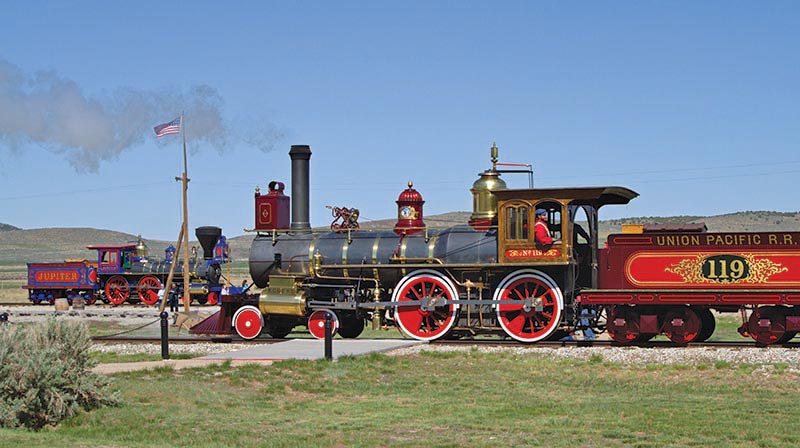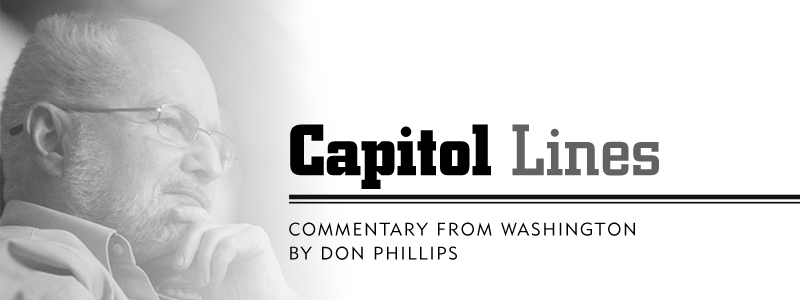 From time to time, we need to step back and look at just how far we have come in the last 150 years. This was the year to do that. A century and a half ago, the nation was joined coast to coast by a railroad at an isolated location known as Promontory Summit. I may get my poetry half wrong, but: “What was it the engines said, pilots touching head to head, facing on a single track, half a world behind each back?”
From time to time, we need to step back and look at just how far we have come in the last 150 years. This was the year to do that. A century and a half ago, the nation was joined coast to coast by a railroad at an isolated location known as Promontory Summit. I may get my poetry half wrong, but: “What was it the engines said, pilots touching head to head, facing on a single track, half a world behind each back?”
I was reminded of this a couple of days ago when I received the Spring-Summer 2019 issue of the journal of The Railway & Locomotive Historical Society. Much of the journal is devoted to a wonderfully detailed look back at the years leading up to the meeting of the engines at Promontory Summit on May 10, 1869, and the years afterward.
The telegrapher at a temporary location watched clumsy politicians try to hammer in the Golden Spike. When the deed was finally done at 2:47 p.m, the telegrapher tapped out “D-O-N-E,” and much of the nation went wild in celebration. Bells across the nation rang out the news, from Trinity Church in New York, City Hall Tower in San Francisco, the Liberty Bell in Philadelphia, as well as hundreds of other locations. Cannons boomed, fire whistles sounded, fireworks blasted. Chicago staged a parade several miles long. The Tabernacle in Salt Lake City was packed to capacity.
It is easy to look back on this era as old-fashioned, but think again. Only the end of World War II and the space program have produced something close to the enthusiasm seen when east and west were joined at Promontory. But nothing has been done in the space program that could produce the hours or days of celebration that took place after Promontory. The celebrations at the end of World War II came close, but they didn’t celebrate something as permanent as the joining of the earth’s hemispheres by rail.
I decided not to go to Promontory for this year’s celebration or to see Union Pacific’s newly restored 4-8-8-4 Big Boy. There would be plenty of time in the future in less crowded circumstances to see the Big Boy. And I’ve already been to Promontory.
Like most great schemes, the building of the Transcontinental Railroad attracted stubborn and self-assured men. The most famous of these men became known as the “Big Four” of the Central Pacific: Collis P. Huntington, Mark Hopkins, Leland Stanford, and Charles Crocker. On the Union Pacific side were Grenville M. Dodge, a talented engineer who was ambitious and self-promoting, and Dr. Thomas C. Durant, who never practiced medicine after graduating from Albany (N.Y.) Medical College, but was always known as “the doctor.”
There wasn’t a lot of trust between the two sides, but they needed each other, so they joined to lobby for changes in the original legislation setting up the building of the line. But first, Union Pacific needed to lobby President Abraham Lincoln to make Omaha the official starting point for the new railroad. Two days before delivering his immortal address at Gettysburg, Lincoln dashed off a confusing executive order that could be interpreted as making Omaha the starting point, as the Union Pacific wanted. For the next four years, leading up to the celebration at Promontory, the two sides did what they could to raise money by any means possible.

Photo by Jeff Terry
Poor Promontory. Today, we see a grand celebration as the earth is neatly tied together; however, the truth is much different. May 10, 1869, was hardly the celebration we imagine today. Yes, it was nice symbolism, but all the real celebration took place elsewhere. Hardly anyone of any significance came up to Promontory. No one, absolutely no one, was there from the federal government. President Grant had wanted to come, but could not. No one stood in for him. In fact, no one from Congress was there. No cabinet or department head was there. Brigham Young sent a bishop in his place. Stanford was the only one of the Big Four to attend. Just about anyone of any significance wanted to be at the big celebrations elsewhere around the country.
Besides, Promontory Summit wasn’t long for the world. The railroads had already agreed that the line through Promontory would be downgraded. Central Pacific would move its terminus nearer to Ogden. Today, there are no big crowds at Promontory, just tourists who want to see the steam locomotives built to resemble the two that met nose to nose in 1869. There was a huge celebration this year to commemorate the 150th anniversary of the Golden Spike, but already a calm has settled over Promontory.
Over the next three decades, the country’s railroad map changed remarkably. E.H. Harriman, a banker who acquired the reputation as the most important and innovative railroad man in the country, brought Union Pacific back from decades of the burdens of federal loans and a federal charter, turning it into a Utah corporation. By the time of his death in 1909, UP had become the most powerful railroad in the country.
Harriman, who also controlled Central Pacific successor Southern Pacific, decided to eliminate the line around the northern end of the Great Salt Lake and replace it with a causeway directly east-west across the lake. Remarkably, only two other major projects were necessary on the original Transcontinental route — eliminating the oxbow just west of Omaha with a direct route nine miles shorter, and replacement of a route west of Laramie, Wyo., to save time that had been insisted on by construction contractors, replacing it with the unbuilt alignment which had been insisted on by Dodge.
I’ve learned a lot doing the research for this column. Get a copy of R&LHS’ Railroad History, No. 220, and prepare for a long read.



